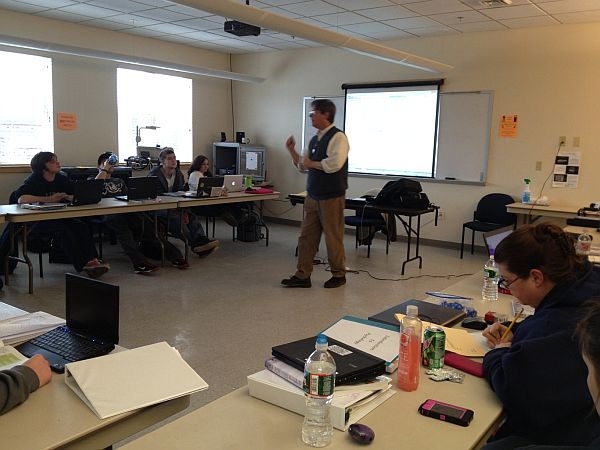
About 85 percent of ninth graders in Vermont complete high school. But less than half of the state’s nineteen-year-olds are enrolled in college.
The state is trying to improve that second statistic by allowing high school students to take free courses for college credit. The aim is to encourage them to seek more higher education. The program is offered by all five state colleges. Postsecondary partners outside the VSC include the University of Vermont, New England Culinary Institute, Champlain College, Burlington College, College of St. Joseph, Southern Vermont College, and Green Mountain College. Some Vermont Technical Center courses also link to colleges.
On a late winter day, about twenty students sat around tables arranged in a horseshoe at Community College of Vermont’s Wilder Center, typing furiously on laptops as Psychology Professor Fred Bennett prepared them for an upcoming mid-term exam.
Paul Moses is eighteen, and hasn’t graduated yet from Thetford Academy. Still, he’s already in college.
"Taking classes here at CCV is a lot cheaper than taking at a regular four-year college," Moses said after class. "So taking classes this semester and also next summer semester I will have generated enough credits to be able to transfer into a four-year college as a sophomore instead of a freshman. So it allows me to sort of jump ahead a year and also save money in the process."
Moses says he isn’t missing anything at high school-he’s already completed graduation requirements. Vermont’s dual enrollment program is also designed for less motivated students who might skip college if they didn’t get a taste of it.
Vermont covers the cost of one free class per student. Now Governor Shumlin wants to offer two free classes, which would cost the state $800,000, initially. After two years, high schools would have to pick up half that tab.
CCV President Joyce Judy says it’s an investment worth making for hundreds of high school students a year.
"And so we’ve seen just a huge interest now in dual enrollment because research does show that students will go onto college," she said.
But not every secondary school administrator is enthusiastic about the dual enrollment program.
Tom Lovett is headmaster at St. Johnsbury Academy, a private school that also admits public school students at state expense.
"If the tuition dollars move from the high school to the college there is a financial disincentive for high schools and a financial incentive for the colleges to happen," Lovett said.
High schools already pay, in some cases, for the dual enrollment tuition, at a time when their own enrollments are already in steep decline.
CCV President Judy says that’s why it’s important for the state to contribute as well, to keep college as affordable as possible. But Headmaster Lovett also has another concern.
"As an educator I am seriously concerned about the culture and climate issues and how we develop strong citizens in our high school communities without passing them up the road too quickly," he said.
But where Lovett sees a weakness, dual enrollment supporters see a strength. They say dual enrollment allows impressionable teen-agers to try out college while they are still living with their parents.